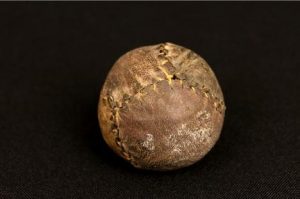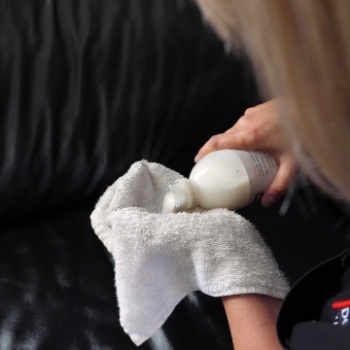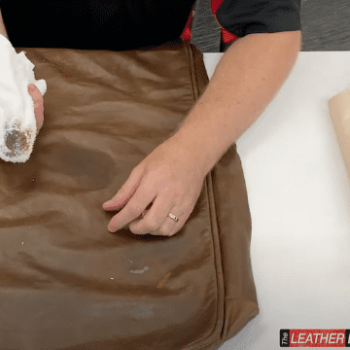It’s fair to say that here at The Leather Doctor, we live and breathe leather cleaning and leather repair. If you’ve been following our blogs you’ll know we’ve covered the many ways we can help you repair and revive your leather and vinyl pieces – whether it’s an accessory or a piece of furniture in your home, car or workplace.
This time though, we thought we’d change it up by sharing our leather knowledge and experience with you. We’ve put together a list of seven interesting facts about leather that you can tuck away for a trivia night, or at the very least, help you make better choices with leather – whether caring for or purchasing it.
Fact 1. Leather goes waaaaaaaay back
The leather industry is considered to be one of the oldest professions in the world. There are paintings and artifacts found in Egyptian tombs dating back to 5000 B.C which indicate that leather was used for many items from military equipment, to shoes and clothing, to household goods like buckets and bottles.
The Middle Ages saw the emergence of leather use for seating due to its durability and comfort while industrialization in the 18th and 19th centuries saw an explosion in the demand for leather in things like belting leathers for driving machinery.
Today, leather is very much ingrained in our everyday life – from what we wear, to books we read, the furniture in our homes to the seats in our cars. It’s clear, leather is here to stay.
Fact 2. Not all leather is made equal
While most leather may, at first glance, seem the same, we’re here to help you understand how it actually differs. If you’re about to make a leather furniture purchase, knowledge on leather types can be helpful before you buy so you know exactly what you’re getting.
All leather starts as a hide from a living, breathing animal and will have natural characteristics and marks which should be viewed as features, not flaws. Leather hides come from many parts of the world.
There are many different types of leather:
• Aniline – Aniline Leather is made from the best available hides and is leather in its most natural state. The leather is coloured with transparent dyes. This transparent dye adds colour but does not hide the natural grain of the leather. Aniline leather will have visible imperfections that are nature’s signature that each piece is unique. Aniline leather has minimal surface protection and is more sensitive to the effect of use.
• Semi-Aniline – Semi- Aniline is covered with a lightly pigmented coat to make the colour uniform and hide minor defects. Transparent and brilliant colours are over-sprayed to reconstruct the natural appearance of the leather. It has a very light protection on it. Semi-Aniline is more resilient to wear than Aniline.
•Pigmented/Topcoat – This is the most widely used finishing technique and appears as a uniform surface by means of a base coat of pigments and resins followed with a protective topcoat. They can be identified by their consistent colour and uniformity of finish. It is ideal for high use items like furniture or automotive seats. Pigmented/top coated leathers are easy to care for and are hard wearing.
• Corrected/Buffed – These leathers are generally lower graded hides with excessive surface imperfection. They are mechanically corrected or buffed and a consistent pattern is embossed into the leather and finished with a pigmented paint and a protective top coat. Special leather and cleaning products used by The Leather Doctor are suited to preserve the look and feel of this type of leather.
• Nubuck/Suede – These leathers are actually Aniline leather that have a sanded or raked surface to give a fine velvet like surface. The look and feel of these leathers is unique and works well for low use applications. Nubuck and Suede leathers are more prevalent in cooler climates but not very common in today’s Australian market place.
• Bycast – This is a completely different system of finishing or enhancing leather (usually split leather or heavily buffed leather) maintaining the same thickness and rigidity. The technique consists of creating a PVC finishing film on a continual support of release paper. An adhesive is applied to the film, then the film is pressed onto split leather. The finished leather is then removed from the release paper, displaying a perfectly uniform hard wearing surface.
Considering all of this information, and how different leathers can be, it is advised that you seek professional help before cleaning and conditioning your leather furniture. If the wrong products are used, they could stain the leather, or draw the moisture from the leather, which may result in long term damage. The Leather Doctor offers free quotes on leather cleaning and conditioning, so touch base with us for assistance and to discuss your requirements.
Fact 3. Golf balls were once made from leather stuffed with feathers.
Golf has been around for quite some time and the nobles who played the sport got fed up with using wooden balls because of the damage they would receive every time a ball was struck. Wooden golf balls were replaced by leather balls filled with feathers.
This trend didn’t stay around for very long but we feel it would have made for a really classy putt!

Fact 4. The colour of leather can be changed, by using paints, not dyes
Many people think that leather is dyed, but it’s not! Leather is coloured using pigments and paints. The process is not as simple as whipping out the paintbrush and cracking open a paint tin though! The process of preparing leather, recolouring it and sealing it, so that it lasts for years to come, is a highly specialised trade and takes a significant amount of skill and training.
Whether your leather or vinyl furniture or finishes have faded due to sun damage, have experienced dye transfer or you simply want to change the colour to match a new interior or to suit current trends, leather re-colouring is a fantastic solution. It is also often a far cheaper alternative than buying new and helps to reduce landfill.
Leather Doctors are extensively trained to colour match leather, allowing them to recolour panels or specifically damaged areas or to completely transform entire furniture pieces or accessories to suit your needs.
Fact 5. Leather texture can change
Being porous in nature, the texture and appearance of leather can change over time depending on the environment it’s kept in. Humidity can soften leather due to the moisture content being absorbed from the air. Winter has the opposite effect, with the dry conditions causing leather to toughen. Our team here is able to help with any issues you may be having with your leather due to weather conditions, be sure to contact us for more advice on how we can help you.
Fact 6. Leather was once used as a very stylish wallpaper.
In the 17th century, it was considered very fashionable to have your home wall papered with leather in Florence and Venice, Italy.
Fact 7. Leather is actually a natural resource and arguably a more sustainable choice
Sustainability is a hot topic right now and many have chosen to associate certain products such as leather as being interlinked with detrimental animal welfare and other unsustainable practices. There are a few things to note here, however. Firstly, leather is a by-product and is not the sole reason for raising livestock, with the hide value only representing 3% of the animal’s value. Secondly, with the rising consumption of meat, there is an increasing excess of hydes, causing wastage. Thirdly, the use of synthetic materials in replacement of leather may not always necessarily be the better choice for the environment or for human use due to either toxicity or biodegradability levels of the materials.
With the aim of helping to reduce landfill and the growth of high furniture turnover, The Leather Doctor aims to help both private customers and businesses repair and restore their leather. Every repair extends a leather item’s useful life, therefore keeping it out of trash piles and land fill for longer. Via our commercial system alone, our franchise network has spared in excess of 24,000 pieces of furniture from turning into ground fill in the past year – a significant contribution to the environment.
We hope you’ve learnt something new with these interesting facts about leather, and can now appreciate a piece of leather furniture or accessory even more. Who knows, it might just also help you make better choices when caring for or purchasing leather items in the future!
Servicing over 8,000 locations across all states and territories of Australia, The Leather Doctors are equipped with the professional knowledge and expertise to be leaders in the leather and vinyl cleaning, repair and recolouring industry. We are committed to excellence for all customers. For a free quote and answers to all your professional leather cleaning and repair questions, contact a friendly team member at The Leather Doctor today!



